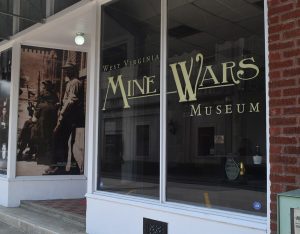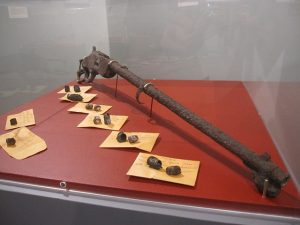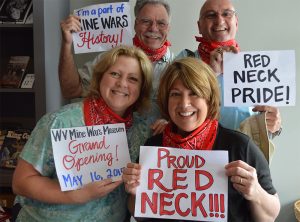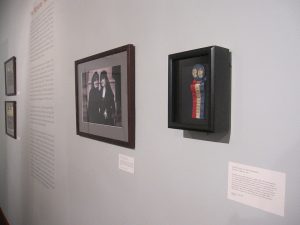AV's Intern Team | June 14, 2016 | 1 Comment
By Molly Moore
On a Saturday in May, a crowd gathered in Matewan, W.Va., to witness a local, all-volunteer cast reenact a bloody clash that affected the struggle to unionize Appalachian coal mines.
The outdoor drama recounts the 1920 shootout alternately known as the Matewan Massacre or Battle of Matewan. During the confrontation, union miners and their supporters faced off against private detectives hired by the coal companies to quash the rising labor movement.

The West Virginia Mine Wars Museum transports visitors to the early 20th century, when local miners fought against powerful coal companies to secure union rights. Inside, the collection presents oral histories, digitized film reels, artifacts, maps and historic photos. Photo by Molly Moore
Nearly 100 years later, the events leading up to that fateful day and the struggles that followed are featured at the West Virginia Mine Wars Museum in downtown Matewan. The museum opened in May 2015 in a building that still bears bullet holes from the confrontation. Inside, exhibits transport visitors to the turn of the 20th century, a time when coal companies exerted a degree of control over the lives of workers and their families that is nearly unfathomable today.
In the early 1900s in West Virginia, many towns were wholly owned by the coal operators. Miners rented company-owned houses and were paid in scrip, which could only be exchanged at the company store. Coal bosses also employed private, armed mine guards to enforce rules and suppress union activity.
That environment, compounded with dangers in the mines themselves, led miners of diverse racial and ethnic backgrounds to unify under the banner of the United Mine Workers of America and demand improved working and living conditions.
At the museum, Kimberly McCoy serves as program fellow, welcoming visitors and imparting her passion for the subject. Her great-great-great uncle was Sid Hatfield, the Matewan chief of police who was at the center of the 1920 shootout, and her grandfather Earklis Perkins, a proud union miner, was buried in his UMWA hat.
“It was a terrible, trying time,” she says of the struggle to unionize the early 20th-century coal camps. McCoy grew up listening to her family’s stories about the hardships they endured and their passionate fight to establish the union. “It was a sacrifice, it was a sacrifice all around. And that’s what we’re trying to preserve.”
Visitors are greeted by an exhibit on coal camp life at the turn of the 20th century, which features black-and-white photographs of miners and their families. Artifacts on display include miners’ helmets and lanterns, household items and a collection of scrip coins emblazoned with company insignia.

Weapons and spent ammunition emphasize the violence of the time period. Photo courtesy of West Virginia Mine Wars Museum
“Between 1890 and 1912, the mines of West Virginia had the highest death rate among the nation’s coal-producing states; its mine-accident death rate was five times higher than that of any European country,” reads a quote from historian David Alan Corbin.
During that time, the UMWA grew in other states, but the union’s progress was slower in the company-controlled towns of southern West Virginia. In 1912 and 1913, more than 12,000 union and non-union workers went on strike at mines in Kanawha County. Demands included union recognition and equal wages. The companies hired hundreds of mine guards through the Baldwin-Felts detective agency to break the strike.
Violence troubled the area for months; mine guards evicted many miners from their homes, and guards set up machine gun embankments. The governor declared martial law, confiscating weapons from both sides and detaining suspected union sympathizers through military courts. By July 1913, after more than 50 directly related deaths, the remaining striking miners accepted a proposal that partially reflected workers’ demands.
At the museum, a replica of one of the canvas tents that evicted miner families lived in features an audio recording in the persona of national union activist Mother Jones, who had a prominent role in the Mine Wars.
Images of local and national union leaders share wall space with photographs of the Baldwin-Felts detectives. “One of the things that we aim to do is to tell this history from multiple points of view and to include multiple voices, and part of that has been the side of management,” says Dr. Lou Martin, a museum board member and a historian and department chair at Chatham University.
After World War I, efforts to unionize southern West Virginia were picking up steam, as was the friction between management and workers. On May 19, 1920, Baldwin-Felts detectives arrived in Matewan to evict striking miners at a nearby coal camp.
When the detectives returned to town, they were met in front of the hardware store by Matewan Chief of Police Sid Hatfield and Mayor Cabell Testerman. Armed miners watched as the pro-union Hatfield attempted to arrest the detectives. Albert Felts, one of the Baldwin-Felts detectives, then attempted to arrest Hatfield. It’s unclear who fired first, but a gun battle ensued that left seven detectives and four town residents dead, including Albert and his brother Lee Felts and Mayor Testerman.

Visitors study a map during the museum’s grand opening. Photo courtesy of West Virginia Mine Wars Museum
Local strikes continued, as did violence between strikers and company agents. The following summer, Hatfield and his deputy, Ed Chambers, were charged with shooting at a coal facility. As the two men and their wives ascended the courthouse steps for the trial on Aug. 1., 1921, Hatfield and Chambers were fatally shot by Baldwin-Felts agents.
Miners across the southern coalfields were outraged. Text on the museum wall explains that a week after the shooting, 5,000 miners assembled in the state capital of Charleston. “You have no recourse except to fight,” local union leader Frank Keeney told the crowd. “The only way you can get your rights is with a high-powered rifle.”
Decades after the 1921 Battle of Blair Mountain, the effort to conserve the battlefield and the mountain has put the area at the center of another sort of conflict: Alpha Natural Resources and Arch Coal both have permits for surface mining on Blair Mountain.
After years of campaigning by historical and environmental preservation organizations, in 2009 the Blair Mountain Battlefield — a 1600-acre portion of the mountain — was added to the National Register of Historic Places.
Though inclusion on the national register doesn’t prohibit mining, it would establish an additional federal hurdle for any mining permits near the battlefield.
The advocates’ 2009 victory was short-lived. Just a few months later, the site was delisted “at the urging of coal companies owning land on Blair Mountain,” according to a recent court document.
But in April 2016, a federal judge declared that the battlefield had been improperly removed from the register, so the decision is now back in the hands of the Keeper of the National Register of Historic Places.
Later that month, miners began assembling in Kanawha County, aiming to march 50 miles, overthrow the mine guard system, and free workers in Logan County who had been imprisoned under martial law. Logan County Sheriff Don Chafin was firmly on the side of the coal companies. “No armed mob will cross Logan County,” he declared, and assembled a force of deputies, mine guards and local volunteers at Blair Mountain along the county line.
After initial skirmishes and a shooting of union sympathizers, tensions boiled over into the Battle of Blair Mountain on Aug. 29. During the fighting, privately hired planes dropped homemade bombs on the miners. Days later, federal troops arrived to suppress the uprising. Federal air power arrived as well, and though the planes never attacked, the museum notes that this was the only time the U.S. government planned to bomb its own citizens. The commanding general declared a cease-fire on Sept. 3, and both state forces and miners began to disband.
At the museum, displays of weapons and spent ammunition underscore the violence of this history. Between 10,000 to 20,000 miners are estimated to have been part of what became known as the Red Neck Army — so named for the red bandanas worn by union miners during the Mine Wars.
After the fighting, 528 people were charged with crimes including treason and murder against the State of West Virginia. Many were acquitted, but some were found guilty. The legal costs and negative publicity took a toll, and state UMWA membership declined dramatically during the remainder of the 1920s. As the museum notes, however, miners ultimately received the rights they sought: “In the 1930s, with Franklin D. Roosevelt’s administration, workers were given the right to bargain collectively and the mine guard system was abolished in West Virginia.”
Pride in Matewan’s union history isn’t new — the town was placed on the National Historic Register in 1997, and visitors can press a button on the exterior wall near the bullet holes from the infamous shootout and hear an audio recording that features excerpts from oral histories collected from local residents. The Matewan Massacre outdoor drama has performed for more than a decade — often multiple times a year. And a visitor’s center, housed within a replica of the town’s historic train depot, also discusses the area’s past. But the brick-and-mortar museum devoted to the Mine Wars represents a new effort to preserve that history.

The term “redneck” can be traced back to union miners who showed their allegiance by wearing red bandanas. Photo courtesy of WV Mine Wars Museum
The museum’s board brings together a diverse group of people, including a local UMWA leader, a Matewan town councilwoman, a retired local teacher, a facilitator, a journalist, historians and the great-grandson of union leader Frank Keeney.
Many of the objects and photographs on display come from local collectors, in particular the museum’s Board President Kenny King, who lives near the historic Blair Mountain site. Efforts to preserve the battlefield and prevent surface mining on Blair Mountain have also pitted citizens groups like the Friends of Blair Mountain against the coal industry, and, at times, the state of West Virginia (see sidebox).

The museum displays a ribbon memorializing Sid Hatfield and Ed Chambers and a photograph of their widows. Photo courtesy of West Virginia Mine Wars Museum
“It’s a subject that for a variety of reasons has been convenient to forget,” says Martin. “And that goes back to the initial participants — many of them would not talk about the events of the mine wars because they still faced potential criminal charges. But it also has been something that at times the state of West Virginia has not wanted to publicize, when they were trying to shed the image of a state that had labor strife in trying to attract new investments.”
The museum is also involved with events such as this spring’s May Day Matinee at the local union hall, which brought more than 50 attendees to listen to old-time music and watch a recent PBS documentary about the Mine Wars.
“Very much as the [coal] industry is in decline, so are communities,” says Elijah Hooker, a Logan County native and museum board member who served as the program fellow in 2015. “I think one of the things that this museum’s got going for it, particularly with the events that we hold, is attempting to reestablish that sense of community.”
Where: 336 Mate St., Matewan, WV
Website: wvminewars.com, see website for the latest hours, special events, places to stay and area attractions
Roughly 2,000 visitors arrived during the museum’s first season, and 2016 is off to a strong start. Some, like a British couple that visited on a recent Sunday, make the journey after watching the PBS documentary or the 1987 film “Matewan.” Others are tourists drawn to the Tug River Valley by the notorious Hatfield-McCoy feud — there are 12 feud sites nearby, along with an extensive all-terrain vehicle trail network named after the famous families.
School groups come from near and far — one class this spring came all the way from Wisconsin’s Carroll University, and board members have presented the story of the Mine Wars to youth across southern West Virginia, in partnership with public schools and the National Parks Service.
According to Martin, volunteer groups performing service in nearby areas often tour the museum and gain a deeper understanding of the region’s past and resilience. Many visitors also come from the surrounding area or have family ties to the mine wars.
“It’s imperative to teach the generations to come about where they came from locally and how strong that their people are,” says McCoy.
Like this content? Subscribe to The Voice email digests
Interesting site. wish we could visit the museum. Well acquainted with the miners’ troubles in the hills of Tennessee. Coal Co. owned the miners of Grundy Co. My father in law helped organize the miners with the help of Myles Horton at Highlander Folk School about 2 miles from my home in Monteagle. the coal co. eventually managed to close the school with the help of nefarious Senator Eastland. but as Myles said, You can close a school, but you cannot close an idea”. It reopened in Knoxville and now is the Highlander Research Center in New market, TN and continues to empower struggling people.
Many thanks to those who keep history alive. “If we don’t learn from history, we are doomed to repeat our mistakes”!!